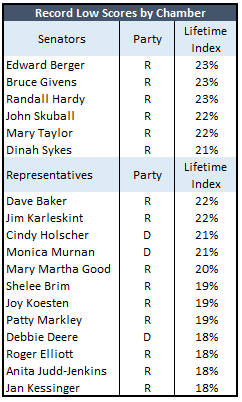The eighteen legislators who set new low scores on the Lifetime Kansas Freedom Index have one thing in common, and it’s not party affiliation. The six senators and twelve representatives were all elected in 2016.
Lifetime Freedom Index scores are reported as percentages, reflecting legislators’ propensity to vote for on legislative actions that positively affect economic freedom, education freedom and the constitutional principles of limited government and personal freedom. Fifty percent is considered neutral on the Index…meaning a legislator with a score of 50 percent voted equally for and against freedom. Someone with a 100 percent score always voted in support of freedom and zero percent obviously tells the opposite. Only those who have served at least two sessions are given a Lifetime Index score.
 The previous low in the Senate was 29 percent; this year’s record low is just 21 percent and the bottom six scores are all Republicans (Berger, Givens, Hardy, Skubal, Taylor and Sykes).
The previous low in the Senate was 29 percent; this year’s record low is just 21 percent and the bottom six scores are all Republicans (Berger, Givens, Hardy, Skubal, Taylor and Sykes).
The previous low in the House was 23 percent but there are four people tied for the lowest score of 18 percent, including three Republicans (Elliott, Judd-Jenkins, Kessinger) and one Democrat (Deere). Six other Republicans and two Democrats also scored below 23 percent.
The five best scores in the House belong to Representatives Jesse Burris (94 percent), Francis Awerkamp (91 percent), Blake Carpenter (80 percent), Randy Garber (80 percent) and Kevin Jones (78 percent). In the Senate, top honors go to Mary Pilcher-Cook (81 percent), Caryn Tyson (81 percent), Dennis Pyle (79 percent), Larry Alley (77 percent) and Richard Hilderbrand (72 percent).
The Kansas Freedom Index is intended to provide educational information to the public about broad economic and education issues that are important to the citizens of our State. It is the product of nonpartisan analysis, study, and research and is not intended to directly or indirectly endorse or oppose any candidate for public office. The annual Index was first published in 2012 and the Lifetime Index was added in 2015.




